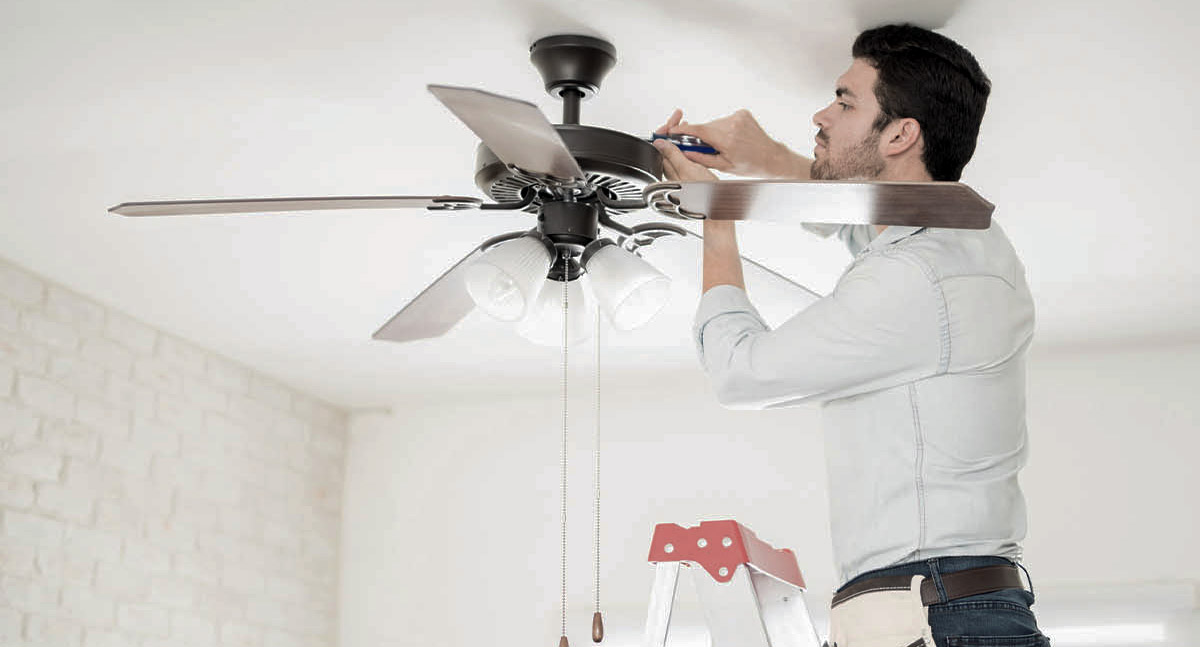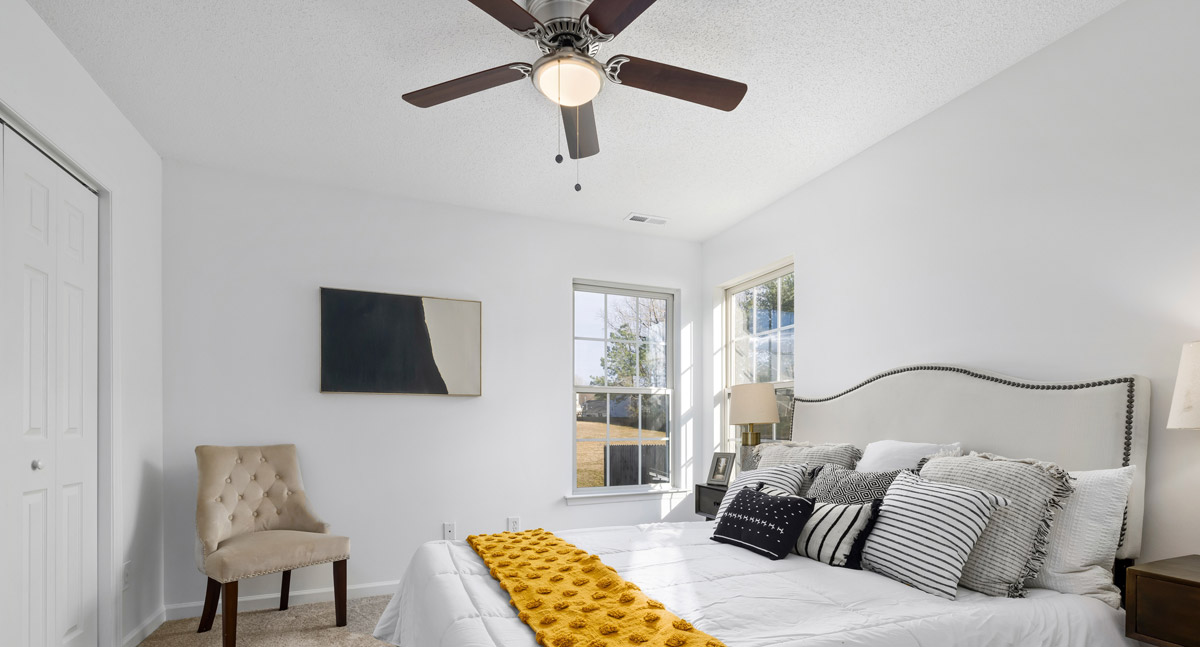If your ceiling fan isn’t providing the airflow you need, don’t worry – you’re not alone! In this blog post, we’ll explore some of the reasons why your fan might not be blowing air and provide some easy solutions. We’ll also discuss what to do if your fan is beyond repair so don’t book that new ceiling fan installation service yet, read on to learn more.
There are many reasons why a ceiling fan isn’t blowing air including:
- Incorrect fan rotation direction
- Incorrect fan blades size
- Tilted base
- Incorrect height
- Wrong ceiling fan style
- Slow fan speed
- Poor quality bearings
- Blades that are misaligned
- Electrical issues
Incorrect fan rotation direction
If a ceiling fan is not blowing air, one potential reason is that the blades are rotating in the wrong direction. Most ceiling fans have a switch on the side of the motor housing that allows you to change the direction of rotation. For summertime use, you’ll want to make sure that your ceiling fan is set to rotate counterclockwise. This will create a wind chill effect that will make you feel cooler.
How to fix it
Resetting or changing the fan’s direction is easy to do. Follow these steps to set your fan to the other direction:
- Turn off the fan.
- Find the switch on the fan’s housing.
- Change the direction by rotating the switch either clockwise or counterclockwise, in essence, setting the fan to operate in the opposite direction.
Incorrect fan blades size
Another potential reason for no airflow from your ceiling fan is incorrect fan blade size. If the blades on your ceiling fan are too small, they won’t be able to generate enough airflow to make a difference. Likewise, if the blades are too big, they may create too much wind resistance and prevent the fan blade from spinning fast enough.
How to fix it
To improve the efficiency of your ceiling fan, replace its blades. A big space would benefit from using a long-bladed fan. Instead, pick fan blades that are between 48 and 60 inches in length. Bigger blades spin more air, allowing you to estimate the room’s square footage based on how much air they move.
The pleasant news is you won’t have to get a new fan or bigger fan if you want to put in new, bigger blades. You can just unscrew each blade and slide the replacement ones in easily. Although, if the larger blades droop and weigh down the motorised fan, they’re probably too heavy.
Tilted base
If the base of your ceiling fan is tilted, it can prevent the blades from rotating properly. This can be caused by an uneven surface or incorrect installation. To fix this problem, you’ll need to level the base of your ceiling fan.
How to fix it
Following these steps to repair the tilted motor base on a ceiling fan:
- Turn the power off to the ceiling fan at your circuit breaker.
- Remove the canopy from the ceiling fan.
- Check that all of the hanger bracket screws are tight by screwing them in clockwise with a Phillips head screwdriver.
- If any of the screws are loose, tighten them until they are snug.
- Reattach the canopy to the ceiling fan.
- Turn the power back on to the ceiling fan at your circuit breaker.
Incorrect height
The height of your ceiling fan is also important for proper airflow. If the blades on your ceiling fan are too close to the ceiling, they won’t be able to generate enough airflow. Likewise, if the blades are too far from the ceiling, they may create too much wind resistance. In terms of how low should a ceiling fan be from the ceiling, under Australian Standard AS 4226 – 2008, Clause 12.5.3 all ceiling fans should be at least 2.1 metres from the floor.
Wrong ceiling fan style
Another potential reason for no airflow from your ceiling fan is that you have the wrong style of fan for your needs. For example, if you have a ceiling fan in a room with high ceilings, it won’t be able to generate enough airflow to make a difference. Likewise, if you have a ceiling fan in a room with low ceilings, it may create too much wind resistance.
How to fix it
If a fan is hanging from a pole, you may simply lift it. If chains are involved, you can remove some of them, or for a pole installation, extend the pole (if applicable). Make slight adjustments no more than one to two inches at a time, test the fan, and make further adjustments as needed.
If you have a fan that is mounted to a stationary base, you’ll need to replace it if the height can’t be adjusted. Luckily, many motor bases are short so that the fan can stay as high up as possible. If, however, you feel like the ceiling is extra high for the fan because it’s vaulted or raised, we recommend using a hanging chain fan instead.
Slow fan speed
If the blades on your ceiling fan are spinning slowly, they won’t be able to generate enough airflow to make a difference. The speed of the blades can be controlled by a switch on the side of the fan motor housing. For summertime use, you’ll want to make sure that your ceiling fan is set to the highest speed.
How to fix it
There are two main ways to increase your ceiling fan’s speed so it can provide enough air for your room. The first is to use the switch on the side of the fan motor housing. The second is to use a remote control. If you have a ceiling fan with a light, the switch will most likely be located on the back of the light housing. If you can’t find a switch, check your owner’s manual.
If your ceiling fan doesn’t have a speed control switch, you can use a remote control to adjust the speed. Ceiling fan remote controls are easy to install and can be found at most home improvement stores like Bunnings.
Poor quality bearings
If the bearings in your ceiling fan are of poor quality, they may not be able to rotate the blades properly. This can be caused by a variety of factors including manufacturing defects, wear and tear, or incorrect installation. If you suspect that the bearings in your ceiling fan are of poor quality, you’ll need to replace them.
How to fix it
If you need to replace the bearings in your ceiling fan, we recommend taking it to a qualified technician or electrician. Attempting to replace the bearings yourself can be dangerous and may void your warranty.
Blades that are misaligned
If the blades on your ceiling fan are misaligned, there can be a common issue where the fan won’t be able to generate enough airflow to make a difference. They will be blowing air, but it might not be going in the right direction. This can be caused by a variety of factors including manufacturing defects, wear and tear, or incorrect installation. If you suspect that the blades on your ceiling fan are misaligned, you’ll need to replace them.

How to fix it
Here are the steps you need to follow to align your ceiling fan blades:
- First, turn off the power to your ceiling fan at the circuit breaker.
- Next, use a ladder to reach the blades of your ceiling fan.
- Once you’re able to access the blades, gently bend them until they’re in the correct position.
- Finally, turn the power back on to your ceiling fan and test it to make sure the blades are aligned correctly.
- If your ceiling fan is still not working correctly after following these steps, we recommend taking it to a qualified technician or electrician. Attempting to fix it yourself can be dangerous and may void your warranty.
Electrical issues
If your ceiling fan isn’t blowing air, one potential reason is electrical issues. This can be caused by a variety of factors including a blown fuse, loose wiring, a problem with the dual or single capacitors, or a defective motor. If you suspect that your ceiling fan has electrical issues, you’ll need to have it repaired by a qualified electrician.
Ceiling fans can be quite helpful during a warm summer day, but nothing’s worse than a running fan that won’t blow air. If your fan is spinning without creating airflow, it’s time to find a solution and we hope this blog post has helped. If you have any questions, please don’t hesitate to reach out to the friendly electricians at Finnley Electrical.


